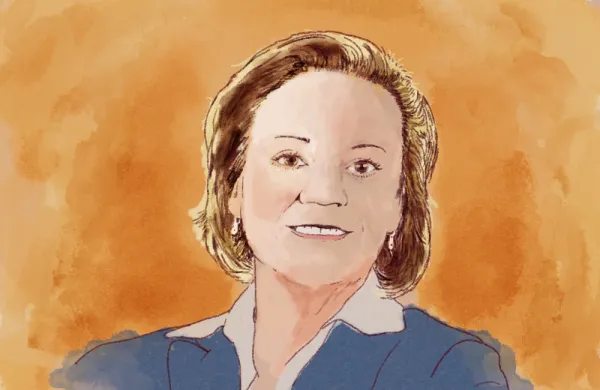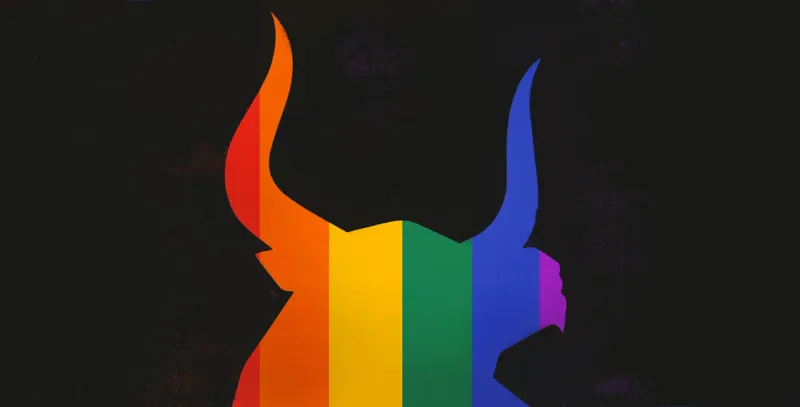
Illustration by Tyler Comrie.
David met David in a straight club on the West Side of Manhattan weeks after the Twin Towers fell.
“Now no one goes to clubs anymore. They all have these apps,” chuckles David Ross, an executive with Viteos Fund Services, which runs operational plumbing for hedge funds and private equity. Ross’s 20-year Wall Street career has taken him to its biggest names: Goldman Sachs, Citigroup’s Salomon Smith Barney group, T. Rowe Price, HSBC, and Merrill Lynch — where he worked that night in 2001 when he met the love of his life. They married six years later. Ross’s husband moved to New Jersey, like so many New York City professionals believe they will never do until they’re co-signing mortgage documents for a three-bedroom in Edgewater.
Then Ross had to quit. At one of these brand-name institutions, Ross’s boss changed — and, not coincidentally, so did his career prospects. “I could totally feel it,” he says of the new manager’s hostility toward Ross, an openly gay man. “My performance reviews changed. But not in terms of my actual performance, but the perceptions of my performance. Until you’ve been discriminated against, it’s very hard to see it. It’s so subtle. There are never really specific comments. You just know. And once it happens, something has to change: you or your manager. I didn’t stay very long.”
The New York Stock Exchange bell pealed that June for Gay Pride Month, as it had for several years prior and annually ever since. The big-name financial firm Ross left had “very solid LGBT protections in place,” he says. Wall Street threw its weight behind the campaign for marriage equality in a stunning and triumphant act of coordinated corporate activism. Big banks have entire squads devoted to recruiting and supporting lesbian, gay, bisexual, and transgender talent, starting with college students. Ross marvels at how far and fast gay rights have progressed in his country and industry — as with all of those interviewed, he occasionally pulls back from nuanced discussion to remark, awestruck, at the turn of events. But the gap between legal and equal remains vast.
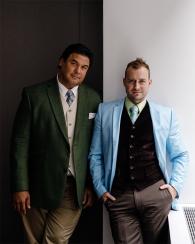
“I’m fully open — totally comfortable with who I am. But I started working for an Indian firm five years ago” — Viteos — “and intuition told me my sexuality could be an issue, so I didn’t talk about it. When I referred to David, I’d say ‘my spouse.’ This is how you survive in the business world.” Ross’s daily work life involves “covering,” the practice of downplaying the known fact that one is gay (or a woman, or black, or disabled, or . . .) to make other people more comfortable. Covering is not pretending to be straight, but rather acting less “gay.” It’s a fact of life outside of the closet.
“I can’t fault someone for their upbringing or force them to see things the way I do,” Ross says. “And I want to be sensitive to those discomforts, especially in the workplace. I wouldn’t say it’s tiring, but other people’s comfort becomes an aspect you have to manage for a career in financial services.” Recently, for example, Ross wanted to add his husband to his company health insurance. He played out the steps of informing HR, thus effectively ending any “don’t ask, don’t tell” dynamic that might exist. “I decided, ‘OK, I’m going to do it.’ These are the things we have to think about.”
Wall Street compels more covering from its employees than less conservative industries. Ross sees it firsthand. “David is totally open — he has a picture of me on his desk. But he’s in advertising.”
Asked if he has one of David on his desk, he pauses.
“No.”
I knew personally two openly LGBT people in finance when this investigation began: one investor and one public relations officer with Prudential.
That number should have been closer to 40, statistically speaking, based on 1,000 LinkedIn connections (many of whom, granted, I don’t know by name much less orientation and gender identity). Roughly one in 25 Americans identify as LGBT, and that proportion holds among high-earning and educated populations, pollster Gallup found in a 2016 survey of 1.6 million U.S. adults. Around half of LGBT people are out in their professional lives in the U.S. (54 percent) and the U.K. (47 percent) — the global hubs of financial services — according to a recent study by the Center for Talent Innovation, a leading think tank, and advocacy group Out Leadership. No solid (or even lousy) data is available on the finance industry specifically, although Goldman Sachs confidentially tracks its own workforce metrics, and other banks are said to do the same.
The international angle makes this tricky for some. Banking and finance, by their nature, are cross-border industries. American LGBT people have some of the most open and accepting workplaces, compared to their colleagues overseas. More than 75 percent of Hong Kong professionals are not out at work; that figure is 80 percent in Russia and 72 percent in Singapore. Those in gay-friendly countries like the U.S., the U.K., South Africa, and Brazil mostly report working for companies with inclusive policies, whereas only a third say the same in Hong Kong and Turkey, and a quarter in Russia and Singapore.
Across the U.S., more people identify as LGBT every year. The number grew by 21 percent, or 1.7 million, between Gallup’s 2012 and 2016 polls. Millennials, born between 1980 and 1998, are “the gayest generation,” more than twice as likely as any other to declare themselves in one of those categories. At 7.3 percent last year, LGBT representation among millennials is bringing the popular “one in ten” legend closer to reality. Most major banks and financial services firms garnered perfect scores on the 2018 Corporate Equality Index, the pan-industry benchmark for LGBT equality and inclusion. In 2002, only JPMorgan Chase & Co. got full marks, versus 79 financial firms this year. Judging by the crop of crowing press releases, gay-friendly is in for big banks.
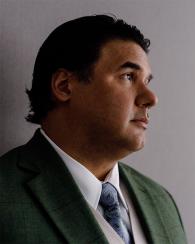
“It’s fascinating to look at,” says Richard Socarides, a prominent gay executive at consultant network Gerson Lehrman Group and a former Clinton White House adviser. “You see the big banks and law firms have made an enormous push to attract LGBT talent, through things like Out Leadership.” The advocacy organization launched six years ago with its first initiative, Out on the Street, before taking on new markets at breathtaking speed. “The main driver of this phenomenon is that these big banks are locked in very hot competition for the best talent. They can’t exclude anybody. And the best talent seems to be attracted to open and diverse places.”
Anyone who has entered the plush segregation of a Manhattan investment conference knows “open and diverse” is aspirational at best. Men, mostly white, hew to a uniform of navy and gray suits, radiating homogeneity that’s either intentional or systemic — but not a fluke. Initiatives to add more women and people of color to the profession’s upper tiers have achieved only marginal success. It’s not lost on Socarides, Ross, or any of those cheering LGBT inroads that most of their standard-bearers are white men. Gender and ethnicity instantly brand someone an outsider. With rare exceptions, there’s no passing as white for a black banker, or as a 20-something man for a middle-aged woman looking to start over as an equity analyst.
Out Leadership’s founder, Todd Sears, points to passing as an advantage LGBT people often have over other minorities. “There’s a much longer and deeper history of challenge for other groups,” he says. “LGBT equality on Wall Street is being driven from the white male perspective, and the white male privilege helps the advance.” Many of the industry’s pioneers came out once they were in positions of power, Sears explains, a former Wall Street banker himself. Some entered into heterosexual marriages and came out later in life, or never had families. The lucky ones came out by choice.
“The AIDS crisis in the ’80s created a crisis where there was none. You couldn’t be in the closet if you were dying of AIDS,” Sears says. The plague swept up Wall Street’s own, including Peter Staley, a JPMorgan bond trader who tested positive in 1985. His brother James, known as Jes, worked there as well, and would go on to lead its asset management and investment banking divisions. “We were both on Wall Street, and Wall Street at that time, you know — the one minority group that was free game for everybody was the homosexual community. . . . I remember, you could use the word ‘faggot’ and whatnot all the way up to, really, 2000, 2001,” Jes Staley said in a 2016 Fortune interview with his brother. “The bank wasn’t ready” for an out HIV-positive gay employee, Peter Staley added. “It would have been explosive. And I might have lost my job. So I did a crazy year where I was a closeted bond trader by day and an AIDS activist by night.” Peter’s activism for AIDS research fueled the discovery of the drug cocktail that would save his life, and millions of others’. Their work imprinted on JPMorgan, which not only scored 100 percent on the inaugural Corporate Equality Index in 2002, but also every year since. “In the ’80s people were forced to come out because of their AIDS status, and now millennials are coming out because they can,” Sears explains.
Social-engineering experiments are underway at the nation’s largest banks to hack the LGBT mind to come out and, as importantly, be out. How does a corporation redefine “normal” within its own walls, and make authentic insiders of outliers?
Hiring diverse sexual orientations and gender identities isn’t enough to foster full performance, research from the Center for Talent Innovation shows, and friendly HR policies are “table stakes,” as one insider put it. Employees who attempted to pass as straight reported ambition and productivity losses on par with people who were out but covering. The less people hide who they are, data suggest, the better they perform at work.
Maribel Ledezma-Williams runs one of the most elite labs for optimizing LGBT talent: Goldman Sachs’ Office of Global Leadership and Diversity. She rose from campus recruiting to become a VP and global co-head of talent development as a specialist in the nascent field. The most effective techniques she’s found involve fewer interventions with the LGBT population than one might expect. To address orientation inequalities, Goldman Sachs took it up with the straight community. The bank launched affinity networks for various groups in 2001, which are open to everyone firmwide. “Oftentimes, there can be a default perception that you must be of X community to have an opinion or awareness,” Ledezma-Williams says. Her team undertook an ally initiative to broaden these groups’ memberships. “It started with engaging really senior people to be sponsor allies, to commit to coming to activities, and to bring people from outside the LGBT community and say, ‘There’s a space for you in this.’”
Likewise, the burden of assessing people’s comfort with diverse sexual orientations falls to HR and Goldman’s gatekeepers. Others can save their brain power for Goldman stuff.
“When people go through their first training, they understand it’s not really optional,” Ledezma-Williams explains. “LGBT inclusion is part of working here. Because we want to be a workplace that fosters inclusion and a meritocracy, it means a place where people feel authentic, and feel comfortable talking about their spouses, their wife, their husband, and not have to self-edit. Where people don’t spend time having to do that self-edit — it affects relationships with their colleagues and with their clients.”
Goldman starts early with prospects. In April a pearl-clutching Fortune headline declared, “Goldman Sachs Wants to Know if You Are Gay.” The firm’s standard job application, including for college students, asks would-be Wall Streeters to identify their sexual orientations and if they are transgender, with the option not to disclose. “We’ve been working for some time on enhancing our self-identification efforts: opportunities for our employees to self-ID,” Ledezma-Williams says. “While we don’t disclose metrics, it’s important for us as a firm to continue to track those numbers.” Other banks have expressed interest in Goldman’s experiment. “We know we’re not the only ones working on this,” she says.
Early on, Goldman Sachs, JPMorgan, and bulge-bracket fellows put their meaningful resources and conservative reputations behind gay rights and marriage equality, powering the movements over the line when success was far from certain.
Californians voted for Proposition 8 — a constitutional amendment defining marriage as between a man and a woman — in 2008. The following year a marriage equality bill failed by a handful of votes in the New York State legislature. In May 2009, Maine’s governor became the first in the nation to sign a marriage equality bill into law. That November, voters repealed it in a referendum. “It was kind of a dark moment,” remembers Brian Ellner, a senior strategist on the New York and national campaigns. “There was a lot of losing going on.”
In 2011, with New York Governor Andrew Cuomo behind it, the state campaign tossed out its usual rolls of Broadway stars and lefty celebrities to go after “what makes New York, New York: celebrities and actors, yes. But also Wall Street, athletes, police officers, and Michael Strahan, and Steve Nash, and Barbara Bush,” Ellner says. Several Wall Street leaders inked their names to a public letter of support, including Goldman Sachs CEO Lloyd Blankfein, then-Morgan Stanley chair John Mack, Tishman Speyer Properties chair Jerry Speyer, and hedge fund bulldog Paul Singer. “Certainly, Wall Street stepping up the way that it did was game changing, and repeated in the fights since,” says Ellner, now in a senior role at financial PR firm Edelman.
The Marriage Equality Act passed in New York state on June 24, 2011. Ellner remembers his phone ringing in Albany, just before state senators entered to vote. “It was Fred Sainz from the Human Rights Campaign, and he said thousands of people had gathered in front of the Stonewall Inn. And he was tearing up, and I was getting misty-eyed. And I can’t believe I am stuck in Albany and not there to celebrate!”
Almost exactly four years later, the fundamental right to marry became the law of the land.
For Robin Diamonte, chief investment officer at United Technologies Corp. and head of its retirement system, it was too little, too late. “My whole life I wanted to get married, to have a big wedding,” she says. “But by the time it happened, it was just too late.” She and her wife, Lori, have been together for 40 years, since meeting in church in their early teens. For domestic partnership benefits, they joined in a civil union in 2005, which then became unconstitutional in 2008, and was finally ruled an automatic marriage in 2010. The nationwide decision “gives you a little bit more comfort and sense that we’re validated,” she says. “But the fact that it can be taken away — it’s almost like it’s too late and not enough. They need to do more.” The couple have two girls, 13 and 11, and travel with a ream of legal paperwork to substantiate that they are a family.
Diamonte once assumed she would never come out. Now she lives openly as a happily married mother of two, a corporate executive responsible for upward of $50 billion, with a presidential appointment (Obama, not Trump) as a national committee adviser. But there was no Maribel Ledezma-Williams to block and tackle discrimination in ’90s corporate America, nor at most financial services organizations today. She put off telling her boss and mentor at a Verizon predecessor. The trepidation made sense. Britt Harris — a lion of the investment world and a devout Christian — tried relentlessly to fix her up with men, until “finally, I had to tell him,” she says.
Harris quotes the Bible at awards dinners. He lives in Texas, and has run two of its most prominent financial institutions: the Teacher Retirement System of Texas and now the University of Texas Investment Management Company. When his protégé came out as a lesbian to him, it was the mid-’90s. “That was probably one of the hardest ones,” Diamonte says. “You want this person to really respect every part of your life. He was very perplexed.” Harris wrote in a statement that Diamonte’s coming out “was a significant revelation because Robin knows that I am a devoted Christian.” But, he continued, “We are called to love all of mankind . . . Jesus said, ‘Let him without sin cast the first stone.’ That certainly would not be me.” He said he agreed to talk to the Lord personally, and work it out with Him. “That sent me on my own path and Robin onto hers.” The two maintain a close, respectful, and beneficial relationship, by both accounts. “It didn’t affect my career at all,” says Diamonte. Harris says, “I have learned a lot through this and hope our story might be helpful to others. I am so pleased with the woman she is and the way she has handled her life.”
“Let’s talk about gayness.” David Ross gives me an arch look over his glasses as we eat Greek caviar, and I’ve asked him to estimate the size of Wall Street’s closet. “There’s no black and white,” he says. “It’s a spectrum of situation, moment, what turns you on. You could be sure you’re completely straight, and meet a woman that for some reason changes your mind. The closet is, I think, an archaic term. Say I’m a financial services executive, and have urges. But now that I’m a little bit older, that doesn’t fit my life publicly, because I’m married to a woman and have kids. If I don’t tell you that, am I closeted?”
Touché. The advocate drumbeat of “out” and “comfortable” for millennials emanates from research linking authenticity with productivity and corporate loyalty. For LGBT professionals born before about 1980, or raised in conservative places, the implication that strategic covering comes from inner conflict might chafe. For me, Ross sets straight the misconception that coming out is a discrete, one-time event, like giving birth or losing one’s virginity. What LGBT professionals in finance describe is both more momentous and iterative, like raising children. After one emerges, the growth and evolution continue.

Sloane Ortel first saw herself as a transgender woman during a long weekend in Philadelphia in October 2016. “I kind of hit a wall. Like, I need to experiment with this. But I was living with roommates, and didn’t necessarily want to come out to my sister and two of my best friends in order to experiment,” says Ortel, 29, who seven years ago began interning at the Chartered Financial Analyst Institute, helped build a daily publication, and now directs content for the 70-country organization. “Tip: If you don’t want to arouse suspicion while accumulating women’s clothing, L.L. Bean is the ultimate sleeper — the least suspicious package in the entire world. I accumulated enough to spend a long weekend in full-on girl mode, and booked to go to Philly. Hideous wig, terrible makeup — a nowhere-to-go-but-up situation. But I pretty much knew the second I let myself out that this was more than an affectation or an experiment.”
Thirteen months later, Ortel’s out to her family, the CFA Institute, and the world. She’s buoyant, grinning beyond all usual standard for an II interview. With the backing of her boss, she’s working from her studio inside a Bushwick art gallery for three months during the “awkward phase.” Ortel went into that and every discussion “prepared to be completely rejected.” She imagined a new, less interesting, less visible role might be found at CFA for her. “Most of the women who come out as trans have already had 20-year careers. Maggie Stumpp” — a pioneering transgender woman at Prudential Financial — “comes out, [but] she already runs the shop!”
But cashing in any longer on her white male privilege was “just not practical,” Ortel says. She’ll only mourn William Charles Gormley Ortel II if her $0.72 appears on her budget spreadsheet, where he’d have earned $1.
Ortel navigates the world through financial analysis. “The thing to understand about transitioning, and shopping, is that you’re making capital allocations under situations of extreme information uncertainty,” she explains. “I don’t know how big my breasts will be or how wide my hips will be. Almost everything I bought is thrifted, because my risk tolerance is not very high for investment pieces at this stage.” Her Wall Street bona fides go back a generation on each side to M&A pro parents, evidenced by the deal toy she proudly shows off on her desk. Her mother, Clarissa Bushman, was among the first women to desegregate Salomon Brothers’ trading floor in the ’80s. Ortel says that makes her a lot more comfortable being different in finance. “She was a ballet dancer beforehand, and definitely stood out. It was challenging for her — all the grotesque locker room behavior that you might imagine. She’d talk about how she spent her day, and it really is, at the bottom, fascinating stuff.” Bushman has fully embraced Ortel’s transition.
“My experience has been that everyone was telling me the truth when they said they loved me,” she remarks. “But I recognize that’s not the base case.” Then she pulls up a statistic famous in the trans community. The rate of suicide attempts for transgender people whose families accept them is 4 percent. For people whose families don’t, it’s 58 percent.
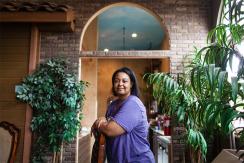
A veil of vulnerability unifies LGBT experiences in financial services, and sets the group apart from many straight professionals. This is a quantitative, risk-oriented population bearing real legal exposure, such as Diamonte’s overturned union. As Out Leadership’s Sears points out, “We can still be fired in 29 states for being gay.” LGBT people are at greater risk of physical violence. That becomes acute when traveling to hostile parts of the world, many of which are common for financial business, including the Middle East. Most say they refuse. “Have I had to go to those places? Yes,” says Ellner, a former corporate lawyer. “Would I choose to? No. Why would anyone?” Venture capitalist Arlan Hamilton turned down an invitation to a tech conference in Jamaica “because I felt like I would be in danger,” she says. “I went once on a tour, and didn’t tell anyone on the ground that I was gay, because I’d heard not to. I wasn’t interested in going back.”
If LGBT professionals navigate their lives carefully, it’s because they’ve learned to. “My introduction to Wall Street was not a positive one,” says Sears. “I entered investment banking in 1998, and I had a homophobic boss. On my second week on the job he called the analyst next to me a faggot. It sent the message to me immediately that this was not a company I wanted to stay with.” Shortly after the election of Donald Trump as president, a senior man in finance told Ortel, “Now we can finally talk about how LGBT people make us uncomfortable.” She had not yet transitioned, but maintained an active online life in the trans community. “Holy shit, that was such a moment,” she remembers. “What are you supposed to say? I was sitting next to people I was out to.” As a response, Ortel told this man about a friend of hers who is trans, about the harassment and death threats she receives.
For many, the most painful experiences are simply those in which they couldn’t be who they are. The night Ross met his husband in 2001, he “wasn’t out at all. It wasn’t something you were about to discuss,” he says. “When we got married I started opening up, and that’s when I started to see discrimination. I ultimately think that we — people in our 40s, 50s, and 60s, — will continue to see that discrimination. But the millennials, that’s not the case. Orientation and gender identity doesn’t matter to them. Once that generation gets into power, things change.”
Nearly half a million more young people will have come out as gay, lesbian, bisexual, or transgender by the end of 2017. They will inherit a more just and open Wall Street, settled by this tough LGBT generation before them. Go forth, fluid financiers. Make your fortunes, fall in love, get married, and move to New Jersey.
Photographs by Ike Edeani. Photo 1: David Ross, an executive at Viteos Fund Services; Photo 2: David Ross, left, with his husband, David Clark; Photo 3: Sloane Ortel, content manager at the CFA Institute; Photo 4: Arlan Hamilton, founder and managing partner at Backstage Capital (photo by Tara Pixley).




